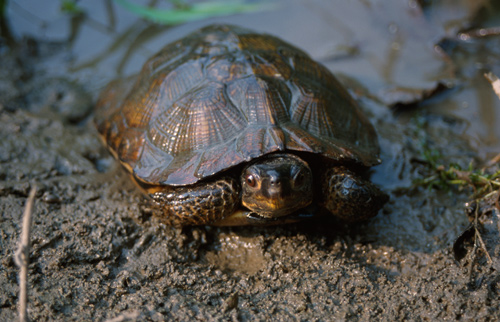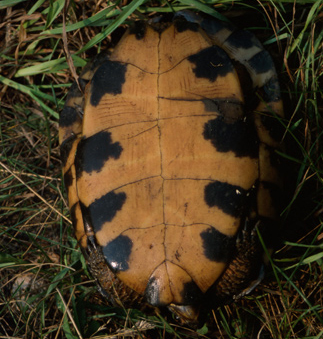The wood turtle is a medium turtle. Its shell, or carapace, is moderately domed and sculptured. It has a black head with a red wash of color under its legs. The lower shell, or plastron, is yellowish or orangish with black markings on the edges. The carapace of wood turtles is 5 to 9 inches long.
Wood turtles range from Nova Scotia southwards to northern Virginia. They range discontinuously westwards through southern Quebec and the Great Lakes region to eastern Minnesota and northeastern Iowa. In Connecticut wood turtles are most common in the eastern and western uplands. Their population in the central regions of the state have diminished from habitat loss, and they were never common in the coastal areas.
These turtles live in cool streams in deciduous woodlands, in red maple swamps, in marshy meadows and can be found in farm country.
Wood turtles breed from March to October, peaking in May and June. They court on land. Males and females approach one another with extended necks. They then lower their heads and swing them back and forth in a performance that can last 2 hours before the pair heads to shallow streams to mate. Eggs are laid and buried in sandy soil in May or June. A female produces one clutch a season and lays 6 to 8 elliptical eggs with flexible shells. Eggs hatch in September or October. Sometimes hatchlings overwinter in the nest in the north and come out in spring. The gender of baby wood turtles is determined by genetics, unlike many other species where gender is determined by the temperature of the eggs during incubation. Wood turtles reach sexual maturity at about 10 years. A wood turtle's lifespan is thought to be at least 50 years and maybe up to 100 years.
These turtles hibernate for the winter, often in dens in overhanging stream banks. They emerge from hibernation in March or April. They bask in the sun on stream banks most often in the spring after they emerge. Turtles cannot regulate their body temperature internally and must warm themselves in the sun. These turtles can climb well and have been known to scale chain-link fences 6 feet tall.
Wood turtles are omnivores. Their diet includes worms, which they often hunt in freshly plowed fields after rain, slugs, tadpoles and wild fruits.
There has been a steady decline of the wood turtle population in COnnecticut because of habitat loss, exacerbated by the late age at which wood turtles reach sexual maturity and the small cluches these turtles lay. They are a species of special concern in Connecticut.

